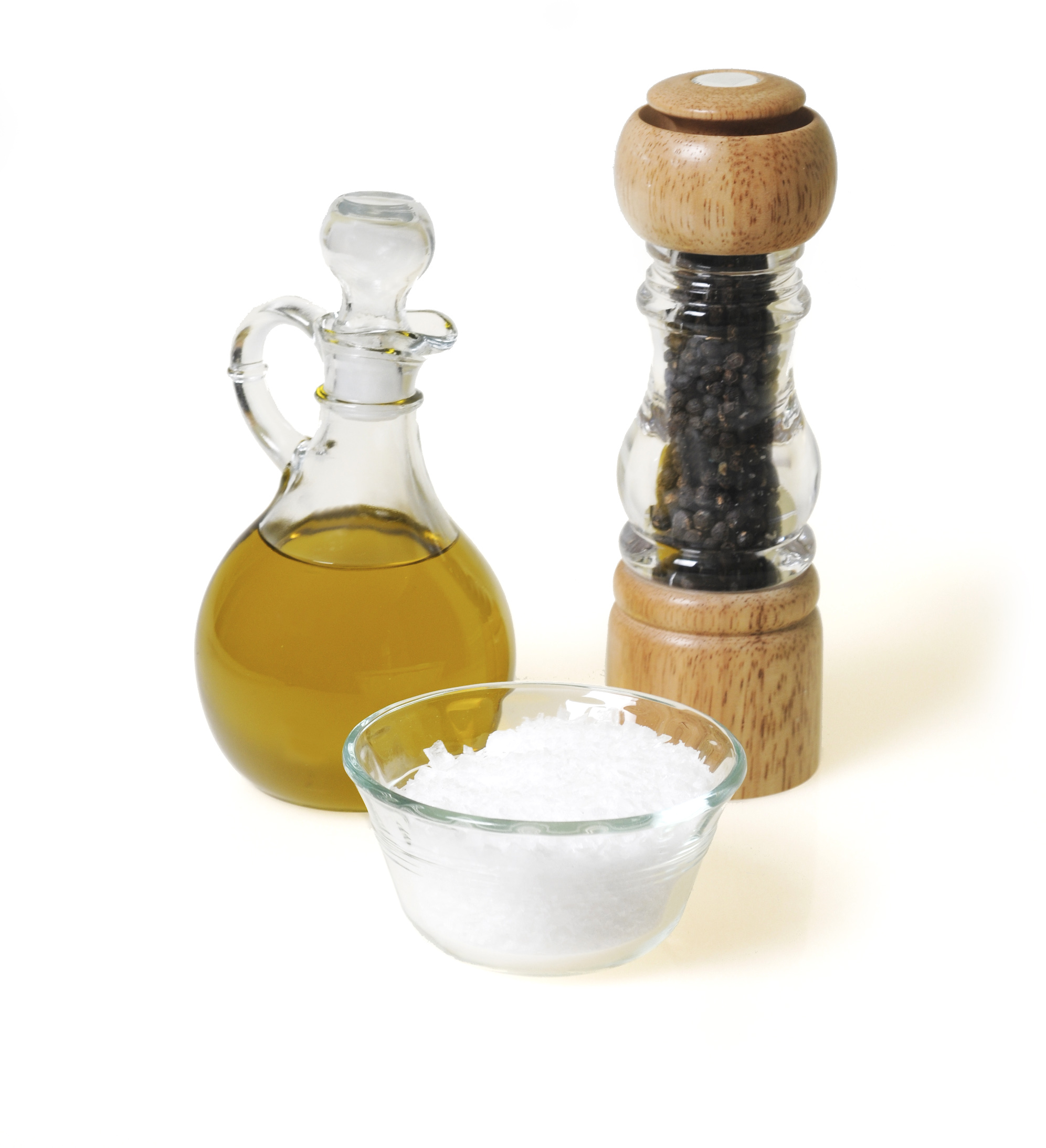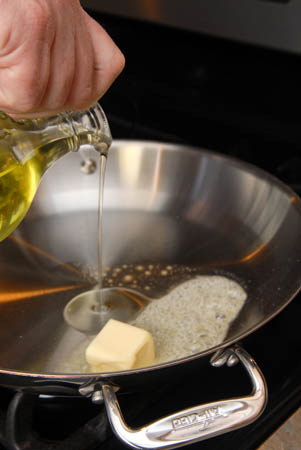In this classic three-part mise en place, oil multitasks by binding the salt and pepper, lubricating the surface of the meat to enhance the development of an exterior crust and to keep the meat from sticking to the cooking vessel, and, depending on your choice of oil, contributing to the overall flavor of the prepared meat.

Oil Types
While there are myriad oils—from roasted nut oils to those made from various grains and fruit—all of them can be classified as either a finishing oil or cooking oil.
Finishing oils are used for their exquisite natural flavors—as a final drizzle on any cooked meat, seafood, poultry, vegetables, pastas, or rice, in salad dressings, for dipping at the table, or almost anything.
Cooking oils are prized for their high smoke point for searing and sautéing.
The smoke point is the point at which high or prolonged heat begins to break down the oil’s structure, turning it bitter and vulnerable to burning in the pan. As a comparison, butter’s smoke point is 350°, while extra virgin olive oil’s is about 410°F and grape seed oil’s is 485°F.
Generally speaking, oils that are high in saturated fat handle high-heat cooking much better than mono- or poly-unsaturated oils that break down and oxidize more readily when exposed to heat. Coconut and avocado oil are among the highest in saturated fat content.
Extra Virgin Olive Oil
The very best quality extra virgin olive oils are first cold-pressed. This means that, after harvest, the olives are ground into a pulp from which the oil is extracted naturally. No heat is used in cold-pressing. Nor are chemical solvents used to refine the oil and treat its flavor. Such extraction processes compromise the quality and flavor of the oil and are used to produce lower-grade oils.
Expensive, cold-pressed extra virgin olive oils are highest in flavor, low in saturated fat, and therefore, best suited to finishing-oil tasks and dressings in which they contribute a significant flavor component.
Pure-graded olive oil has better heat tolerance—a higher smoke point because it is a blend of virgin and refined olive oil. Consequently, it is ideal for sautéing and searing but doesn’t offer much flavor. And, in some cases, a neutral flavor is exactly what you want. Olive oil can be used for sautéing. However, olive oil graded pure will have a higher smoke point than extra virgin olive oil.
Hint: When you want the flavor of butter in a sautéed dish, you can raise butter’s smoke point by using equal amounts of butter and olive oil.

Roasted Nut Oils
Roasted nut oils are another category of high-flavor oils. These oils usually have assertive, concentrated flavors that sort of take over the flavor of a recipe. For example, roasted sesame oil is a very identifiable flavor component of Asian cooking.
In most recipes, a relatively small amount—even just a couple of drops—is all that’s required. You would never use a roasted nut oil for deep-frying or solely for sautéing.
Walnut, hazelnut, pistachio, and almond are all high in saturated fats so they are fine for a light coating on meats before cooking or as a final drizzle when the meat comes off the heat. A pairing of a roasted nut oil with a neutral oil such as peanut or grapeseed are great for a light vinaigrette.
Grapeseed Oil
For a mise en place when cooking steak, the higher the smoke point the better. Grapeseed oil is preferred by the French for sautéing and has one of the highest smoke points around. However, it has a relatively neutral flavor—which, in some cases, is what you want.
Storage
Light is enemy number one when it comes to the best quality olive oils. Exposure to light will degrade the oil prematurely and, ultimately, turn the oil rancid.
Even if the oil is in a dark green glass bottle, store it in a dark cupboard. Spritzers with opaque housings, olive oil cans, or ceramic bottles are acceptable for counter storage.
Choosing an Oil
How many oils do you need in your pantry? As many as you want—but, it’s always a good idea to have a finishing-quality oil and a cooking-quality oil, or one that cuts down the middle.
In Lobel’s Pantry, the Salute Sante Grapeseed Oil is the best choice for high-heat sautéing, while the Zoe Extra Virgin Olive Oil is an excellent all-purpose cooking oil. As for finishing oils, the Fondo di Toscano Extra Virgin Olive Oil is a classically fruity Tuscan oil with a slightly peppery finish. On the other hand, Moulins de la Brague Huile d’Olive Virge Extra is a lush oil with smooth buttery notes.
What’s your go-to mise en place oil? Have you ever tried grapeseed or one of the off-the-beaten-path oils?



Leave Your Response